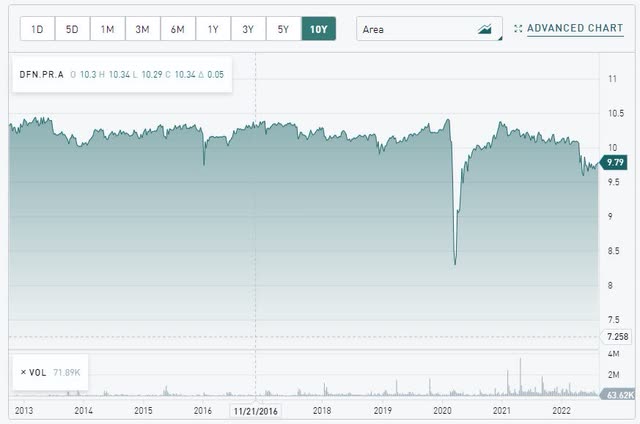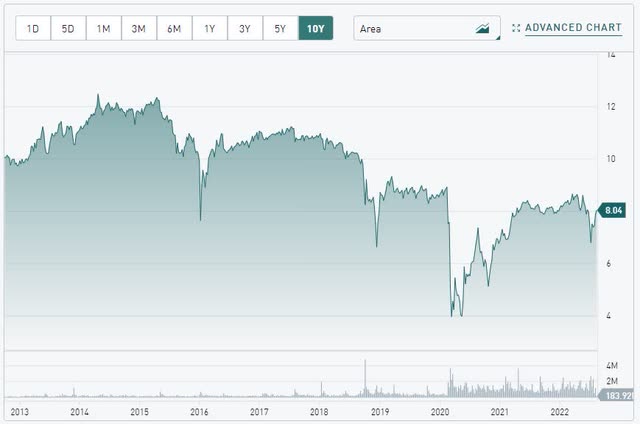ronstik/iStock via Getty Images
Split Share Funds such as Dividend 15 Split Corp buy stocks and create two classes of shares – one for capital gain and the other for dividends. The Canadian market has an interesting investment product called a split share fund. At first glance it can be very confusing. A basket of dividend stocks is spun off into two classes of shares – both receiving monthly payments.
- What are the risks?
- Which of the two classes of shares should you hold… if any?
The focus of this article will be the Quadravest Dividend 15 Split Corp (DVSPF) (TSX:DFN.PRA:CA).
Dividend 15 Split Corp.
The following blurb is taken directly from the Quadravest website.
DIVIDEND 15 SPLIT CORP. is an investment corporation designed to pay monthly cash dividends. The corporation invests primarily in a portfolio of 15 dividend yielding, high quality Canadian companies. Two types of shares are available: a Class A (DFN) and a Preferred (DFN.PR.A).
Let’s break this down step by step. All prices will be in Canadian dollars.
15 Blue Chip Dividend Stocks
First, Quadravest selects 15 blue chip quality dividend stocks in Canadian markets. Actually, there are 20 here because the fine print says they can add more. But the branding doesn’t sound quite as good if they called it Dividend 15-or-so Split Corp.
Over half of the overall portfolio weight comes from financial companies.
- Royal Bank of Canada (RY:CA)
- Toronto-Dominion Bank (TD:CA)
- TC Energy Corp (TRP:CA)
- Bank of Montreal (BMO)
- Canadian Imperial Bank of Commerce (CM)
- Bank of Nova Scotia (BNS:CA)
- BCE Inc (BCE:CA)
- Manulife Financial Corp (MFC:CA)
- Enbridge Inc (ENB)
- Sun Life Financial Inc (SLF)
- Suncor Energy Inc (SU:CA)
- National Bank of Canada (OTCPK:NTIOF)
- Thomson Reuters Corp (TRI)
- TELUS Corp (T:CA)
- TransAlta Corp (TAC)
- CI Financial Corp (CIX:CA)
- Loblaw Companies Ltd (L:CA)
- Emera Inc (OTCPK:EMRAF)
- AGF Management Ltd (AGF.B:CA)
- TMX Group Ltd (OTCPK:TMXXF)
Creating Two Classes of Shares
The next step is to create two classes of shares.
- The Preferred share group will receive yield from dividends only. No capital gains or losses.
- Class A will receive whatever is left over – which is almost exclusively capital gains or losses.
I realize that Quadravest is paying monthly distributions but we will ignore that for now. Let’s focus on how this product is structured first.
For this illustration we will assume an investment of $250,000 total. $100,000 goes towards preferred shares and $150,000 goes towards Class A shares. This is the ratio that Dividend 15 Split Corp. has used.
- 1:1.5 – Preferred to Class A ratio.
We take the $250,000 total investment and we buy a basket of 15 dividend paying stocks (or 20). From here, we calculate what the total dividends would be on the entire $250,000 and we give some of that to the Preferred shareholders. Maybe not all of it but enough to make it worth their while.
Suppose the portfolio dividend yield is 3.5% when formed or $8,750 on the $250,000 investment. If we gave all of that to the Preferred Shareholders, they would have an annual dividend return of $8,750 or 8.75%. That seems a bit high so we ‘guarantee’ them 5.5% annually. They get the dividend but none of the capital appreciation or depreciation. Their dividend payment seems pretty safe because it is fully funded from the portfolio dividend and even if some companies freeze, cut or discontinue paying their dividends, there should be more than enough wiggle room to cover it. Furthermore, the return of the initial share price has priority over the second class of shares.
What about the Class A Shareholders? For $150,000 investment they get $250,000 worth of stock to trade. They will incur leveraged gains and losses based on their $150,000 investment. Another way of looking at it is that they are paying 5.5% in annual interest to trade on leverage.
Monthly Distributions
It should be fairly clear as to where the returns are coming from for each share class.
- The preferred shares get the lion’s share of the portfolio dividends and nothing else.
- The Class A shares get leverage and in return give up most of the portfolio dividends as a form of loan interest, if you will.
In order to make the Class A shares more desirable (because you need to sell an equal amount of preferred and Class A shares), Quadravest pays a monthly distribution to Class A shareholders at a target yield of 8% per annum. Where does this distribution come from?
A small portion of the Class A monthly distribution may come from the dividends that is not given to preferred shareholders. The majority of the distribution will come from capital gains – assuming that share prices go up. The firm can also engage in covered call writing to generate additional funds.
It is important to note that Class A shares may not generate any monthly distributions if share prices fall. On the other hand, if share prices go up a lot, you will get your regular monthly distribution plus you may also receive a special dividend at the end of the year for the amount in excess of 8% plus other fees already paid out to you.
My Take on the Preferred Class of Split Shares
The Preferred class definitely seems like the better of the two share classes. The risk is much lower as your distributions are funded from dividends. You will likely receive a higher yield than directly investing in the underlying shares. And you are shielded from share price movement – up or down.
There can be an increased risk of loss if you suddenly need to sell or retract your shares sooner than the 5 year term. But I would not recommend doing so. Your monthly distributions come from dividends. And even if dividends are reduced or cut, you should still receive your initial investment back plus the dividends promised. You have a priority claim on assets ahead of Class A shares. At the end of the 5 years when stocks are sold, you should receive everything you were promised. Unless of course there isn’t even $100,000 worth of shares remaining out of the $250,000 worth of initial combined investment. But that would be incredibly rare.
Below is a chart of the Preferred Shares trading in Canadian Dollars.
I cannot think of a single good reason why someone would want to retract shares at a 15% loss (in 2020) when your investment is covered from Class A shares. Perhaps preferred shareholders…. nope. I’ve got nothing. I cannot see the point of trying to retract shares in a moment of panic at a 15% loss. The dividends were paid month after month. Preferred shares have a priority claim ahead of Class A shares on the fund’s assets at windup.
- If you are happy with the 5.5% annual yield (or whatever the current rate is set at), this can be a moderately low risk method of getting that yield.
My Opinion of Class A Shares
My take on the Class A shares is a bit different. You are essentially just buying on leverage. Is it worth it? To answer that I would calculate how much you are giving up for the extra leverage that Class A shares provide. 5.5% plus other fees. Can you get leverage for 7% or less? Maybe with Interactive Brokers but with other brokerages you might be paying around 11% currently. So if your goal is to trade on leverage, you desire a monthly distribution and you are happy with the cost of leverage via Class A shares – then I would say go ahead.
This next chart shows the increased volatility of the Class A shares which is essentially the underlying shares with leverage.
On the other hand, don’t be sucked in by the 8% per annum target dividend paid out in monthly distributions for Class A shares. That is just a number they pulled out of their hat. You only make money if the share prices go up. You do not get a monthly distribution if share prices are under water. If share prices do not go up – all those distributions paid to you over 5 years will be reflected once they return a reduced portion of your original investment. And that loss will be magnified because of the leverage employed. Only buy Class A shares if you are interested in trading with leverage.
Final Thoughts
For me, I feel there is some merit in the Preferred Class of split shares with Dividend 15 Split Corp. You get a decent yield at lower risk. I also feel that the Class A shareholders bear the brunt of that risk. Provided they understand they are just paying for leverage, that’s fine too. But buying Class A shares is not something I would personally do. Or recommend. But unless there are Class A shareholders, there cannot be Preferred shareholders. So we have a chicken and the egg scenario.




Be the first to comment